How to View All Open Windows on Your Computer
On Windows 10

Use Task View to see all your windows on one screen. By default, Task View is the icon with three rectangular windows and a slider button on the right that appears on the taskbar. Clicking it will show you all your open windows on one screen, and it's the easiest way to see all your open windows.
If you don't see the Task View button on the taskbar, right-click the taskbar and select Show Task View Button . You can also open Task View by pressing the Windows key + Tab .
If you've created virtual desktops to use multiple apps, click each virtual desktop in the bar above Task View to see the windows open on that desktop.

Choose to view windows stacked, in columns, or side by side. Another way to see all open windows on one screen is to arrange them using the taskbar options. Right-click the taskbar, and choose one of the following options to see all open windows:
Select Cascade windows so you can view open windows stacked on top of each other and see the title bar of each window.
Select Show windows stacked to display all open windows in one or more columns. The number of columns will depend on the number of windows open.
Selecting Show windows side by side will display windows in rows instead of columns.

AltTry pressing the +Tab ↹ key combination to view and switch between apps. Release the Tab key while still holding the Alt key to view all open windows. This is a quick way to switch between open apps using the keyboard instead of the mouse, and is also a convenient way to see which windows are open.
To switch to another window, you'll use the Tab key (and keep pressing the Alt key ) to cycle through your open apps. When you find the app you want to view, release both keys.
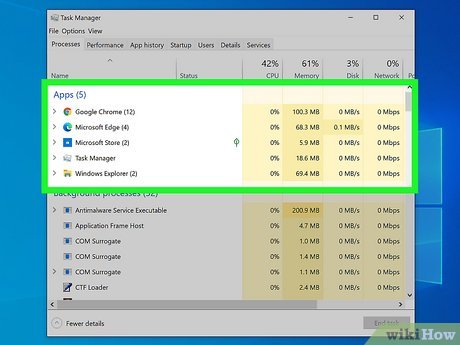
View all open apps and tasks with Task Manager. Task Manager displays all apps and background processes running on your Windows computer. You can open it by pressing Control + Shift + Esc at the same time, or by right-clicking the taskbar and selecting Task Manager .
When Task Manager opens, you'll see a list of open applications. Click More details to see more information, including a list of background processes running.
Applications in the "Apps" area of the Processes tab all have windows open or minimized.
On Windows 11
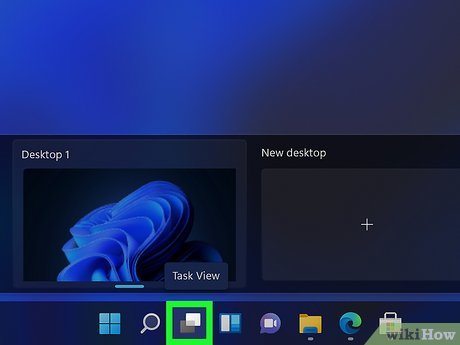
Use Task View to see all your windows on one screen. Task View looks like two overlapping squares — one white and one gray — and is usually found on the taskbar at the bottom of your screen. You'll see all your windows on one screen, and it's the easiest way to see all your windows. You can also open Task View by pressing Windows key + Tab .
If you don't see the Task View icon on the taskbar, right-click the taskbar, select Taskbar settings , and click the slider next to "Task View" to turn it on.
If you use virtual desktops to open multiple apps, you'll see each desktop below Task View. Click a desktop to see the windows open on that desktop.
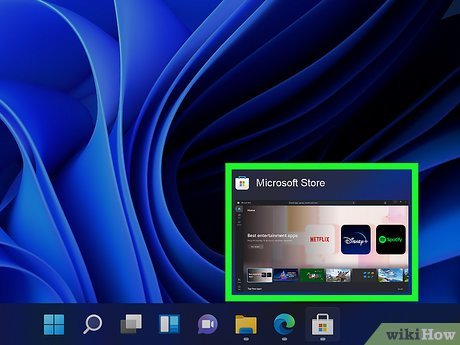
Hover over a taskbar icon to see a quick view. When you open an app in Windows 11, its icon appears on the taskbar. Apps with open windows have a white underline on the taskbar. Hover over an icon with a white underline to see a thumbnail of the open window. You can click one of the thumbnails to open that window.
Hover over the Task View icon to see all your open desktops. You can click one of them to view them.
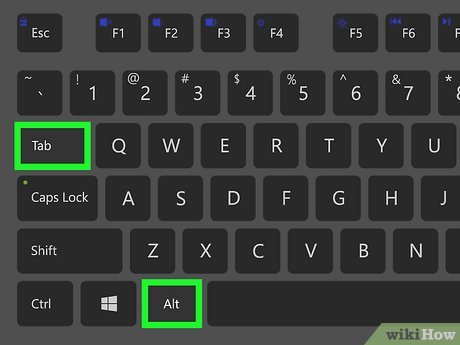
Press Alt+Tab ↹ to view and switch between apps. Release the Tab key while holding the Alt key to view all open windows. This is a quick way to switch between open apps using the keyboard instead of using the mouse, and it's also a quick way to see open windows.
To switch to another window, use the Tab key (while still holding down the Alt key ) to cycle through your open applications. When you find the application you want to view, release the keys.
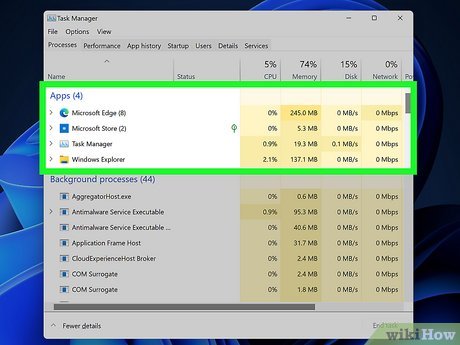
View all open apps and processes with Task Manager. Task Manager displays all apps and background processes running on your Windows computer. You can quickly open Task Manager by pressing Control + Shift + Esc at the same time, or by right-clicking the taskbar and selecting Task Manager .
When Task Manager opens, you'll see a list of open applications. Click More details to see more information, including a list of processes running in the background.
Applications in the "Apps" section of the Processes tab all have windows open or minimized.
On Mac
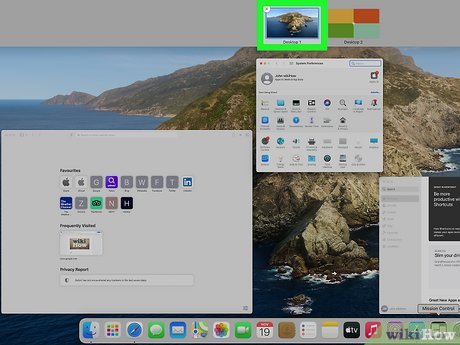
Use Mission Control to see all open windows on one screen. This is the easiest way to see which apps are open on your Mac. If you create a Space to use multiple apps, you'll see each Space at the top of Mission Control. Click a Space to see its open windows. To open Mission Control, follow these steps:
For Apple keyboards, press the Mission Control (F3) key in the top row of keys. It's the key with an icon of three small rectangles inside a large rectangle.
If you're using a MacBook, use three fingers to swipe up on the trackpad.
If your MacBook has a Touch Bar, you'll tap the three rectangles icon.
If you're using a Magic Mouse, tap the mouse twice with two fingers.
Press the Control + Up Arrow keys on your keyboard at the same time.
Double-click the Mission Control application in the Applications folder.
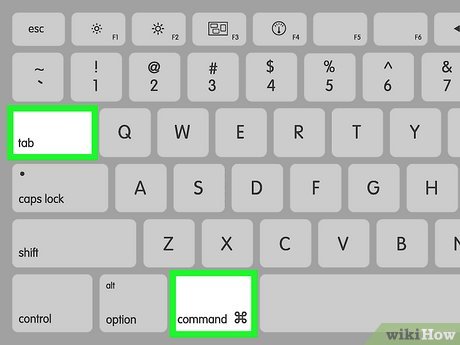
Press ⌘ Command+Tab ↹ to view and switch between apps. This is a quick way to see all your open apps. When you press this key combination, release the Tab key but keep pressing the Command key to see your open apps.
To switch to one of the open windows, keep pressing the Command key , press the left and right arrow keys to select the application you want to use, and release the Command key to see the screen clearly.
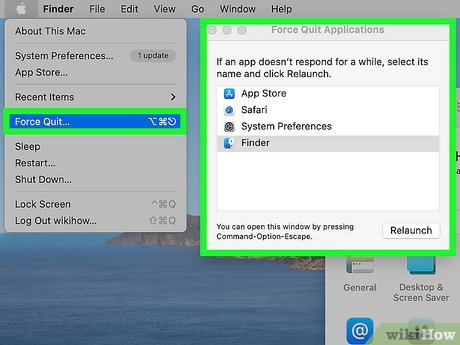
Open the Force Quit menu to view and close open apps. Force Quit helps you close apps quickly, but you can also use it to quickly view open apps on your Mac—even minimized ones. To open this menu, press Command + Option + Esc at the same time.
You can close the application on this window by selecting it and clicking Force Quit .
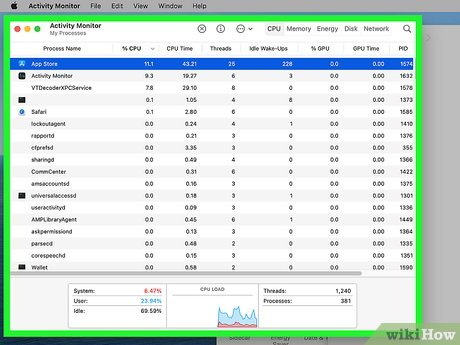
See all your running apps and processes with Activity Monitor. Activity Monitor not only shows you which apps are open, but also shows you how much memory, battery, and CPU power each app is using. To open Activity Monitor, go to the Applications folder in Finder, double-click the Utilities folder , and then double-click Activity Monitor .
Activity Monitor also displays information about processes running in the background, alongside applications with open windows.
Click the tabs at the top of Activity Monitor to see what resources each app or process is using.
You should read it
- Instructions to make ghost animations posted on Facebook
- Enable Google Prompt to improve 2-layer security
- The most experienced mobile app 2018
- Apple first sold laptops under $ 1,000
- LCD screen: The row of 'graveyards' is very risky
- Russian Hacker performs a new attack tactic
- Warning: FaceApp, the hot face change application for young people, contains a hidden danger
- This AI 'doctor' is being used to quickly diagnose Corona virus
May be interested
- Get back Windows Photo Viewer on Windows 10 to help you see photos faster, Photos too slow!
 if you don't like photos on windows 10 and want to view photos with windows photo viewer on windows 10, follow this guide to bring windows photo viewer to windows 10, help you see photos faster.
if you don't like photos on windows 10 and want to view photos with windows photo viewer on windows 10, follow this guide to bring windows photo viewer to windows 10, help you see photos faster. - How to hide the 'Task View' button on Windows 11
 similar to windows 10, windows 11 provides users with a 'task view' button on the taskbar (taskbar). when you click this button, you can see a list of tasks running in the system, especially open files, windows and desktop.
similar to windows 10, windows 11 provides users with a 'task view' button on the taskbar (taskbar). when you click this button, you can see a list of tasks running in the system, especially open files, windows and desktop. - Change the default Control Panel view to a Windows computer
 by default, windows control panel will display the view by category: category, large icons, or small icons. however, if you want to open the control panel window to display specific items fully, you can use the registry or group policy to edit them.
by default, windows control panel will display the view by category: category, large icons, or small icons. however, if you want to open the control panel window to display specific items fully, you can use the registry or group policy to edit them. - 7 ways to fix Notepad not opening error on Windows
 notepad is a simple text editor that comes pre-installed on your windows computer. you can use it to view, create and edit text files whenever needed. but what if windows can't open notepad and you can't use it?
notepad is a simple text editor that comes pre-installed on your windows computer. you can use it to view, create and edit text files whenever needed. but what if windows can't open notepad and you can't use it? - How to open the Photos app on Windows 10
 windows 10 introduces the photos app to easily view, browse and organize digital photos on your device. this article will show you some ways to open the photos app on windows 10.
windows 10 introduces the photos app to easily view, browse and organize digital photos on your device. this article will show you some ways to open the photos app on windows 10. - 4 ways to view images * .DWG does not need to install Autocad
 to open * .dwg images on the computer, users can completely use different support tools without having to install autocad software on the computer.
to open * .dwg images on the computer, users can completely use different support tools without having to install autocad software on the computer. - How to View Archived Instagram Posts on Windows or Mac
 while you can't easily view archived instagram posts using your windows or mac computer, you can use bluestacks and view the mobile version of the instagram app on your computer. this article explains how to view archived instagram content using bluestacks on a windows or mac computer.
while you can't easily view archived instagram posts using your windows or mac computer, you can use bluestacks and view the mobile version of the instagram app on your computer. this article explains how to view archived instagram content using bluestacks on a windows or mac computer. - How to view Windows computer uptime
 do you know how long you've been using your computer since it started? to know the time the computer is open or exactly the time the computer is used, there is a time check tool on windows.
do you know how long you've been using your computer since it started? to know the time the computer is open or exactly the time the computer is used, there is a time check tool on windows. - How to Open a Pages File on PC or Mac
 this wikihow teaches you how to view the text, graphics, and images in a pages file, using a desktop computer. the pages app is exclusive to mac os, but you can still see a preview of the file on windows. open the folder containing your...
this wikihow teaches you how to view the text, graphics, and images in a pages file, using a desktop computer. the pages app is exclusive to mac os, but you can still see a preview of the file on windows. open the folder containing your... - How to open and view GIF images and animations on Mac
 although the preview application can handle and allow users to view all types of image formats on mac, the limitation of the application is that it cannot open and process gif image formats properly. in the article below tipsmake will guide you how to open and view gif images and animations on mac.
although the preview application can handle and allow users to view all types of image formats on mac, the limitation of the application is that it cannot open and process gif image formats properly. in the article below tipsmake will guide you how to open and view gif images and animations on mac.










 How to diagnose computer errors through beeps - Computer error reporting through beeps
How to diagnose computer errors through beeps - Computer error reporting through beeps Speed up Internet connection on Windows 11 computer
Speed up Internet connection on Windows 11 computer How to block websites on your computer without installing software
How to block websites on your computer without installing software 8 Ways to Fix Windows PIN Not Working in Windows 10/11
8 Ways to Fix Windows PIN Not Working in Windows 10/11 This hidden score shows how well a computer runs Windows
This hidden score shows how well a computer runs Windows This is the easiest way to reinstall Windows 11 and fix the problem!
This is the easiest way to reinstall Windows 11 and fix the problem!